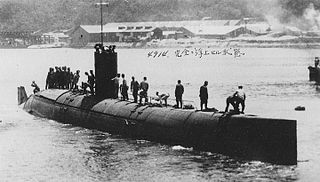Ro-45 was an Imperial Japanese Navy Kaichū type submarine of the K6 sub-class. Completed and commissioned in January 1944, she served in the central Pacific Ocean during World War II and was sunk in April 1944 during her first combat sortie.

The I-121-class submarine was a class of minelayer submarine in the Imperial Japanese Navy (IJN), serving from the 1920s to World War II. The IJN classed it as a Kiraisen type submarine. The type name, was shortened from Kirai Fusetsu Sensuikan.
I-23 was a Type B1 submarine of the Imperial Japanese Navy during World War II. After a raid on the West Coast of California she participated in an attempt at a second attack upon Pearl Harbor. After surviving an American air attack on Kwajalein I-23 was lost in early 1942 with all hands somewhere off the Oahu coast of Hawaii.

I-53, later I-153, later I-153, was an Imperial Japanese Navy Kaidai-class cruiser submarine of the KD3A sub-class commissioned in 1927. During World War II, she supported Japanese forces during the invasion of British Malaya in December 1941 and the Dutch East Indies campaign in early 1942. She served as a training submarine until she was hulked in January 1944. She surrendered to the Allies at the end of the war in 1945. She was either scuttled in 1946 or scrapped in 1948.

Ro-64, originally named Submarine No. 79, was an Imperial Japanese Navy Type L submarine of the L4 subclass. First commissioned in 1925, she served in the waters of Japan and Chōsen prior to World War II. During World War II, she operated in the Central Pacific, supported the Japanese invasion of Rabaul, and took part in the Aleutian Islands campaign, then in late 1942 was relegated to a role as a training ship. She was sunk in April 1945.
Ro-39 was an Imperial Japanese Navy Kaichū type submarine of the K6 sub-class. Completed and commissioned in September 1943, she served in World War II and was sunk on 1 February 1944 during her first war patrol off Wotje with all 70 hands onboard lost.
Ro-40 was an Imperial Japanese Navy Kaichū type submarine of the K6 sub-class. Completed and commissioned in September 1943, she served in World War II and was sunk in February 1944 during her first war patrol.
Ro-49 was an Imperial Japanese Navy Kaichū type submarine of the K6 sub-class. Completed and commissioned in May 1944, she served in World War II and patrolled off the Philippines and the Ryukyu Islands. She was lost during her third war patrol sometime in late March or April 1945.
The second Ro-56 was an Imperial Japanese Navy Kaichū type submarine of the K6 sub-class. Completed and commissioned in November 1944, she served in World War II and was sunk during her first war patrol in April 1945.
Ro-108 was an Imperial Japanese Navy Ro-100-class submarine. Completed and commissioned in April 1943, she served in World War II, operating in the Solomon Islands campaign, the New Guinea campaign — during which she sank the United States Navy destroyer USS Henley (DD-391) — and off the Admiralty Islands. She was sunk in May 1944 during her fifth war patrol.
Ro-116 was an Imperial Japanese Navy Ro-100-class submarine. Completed and commissioned in January 1944, she served in World War II and was sunk in May 1944 during her second war patrol.

Ha-201 was an Imperial Japanese Navy Ha-201-class submarine. Completed and commissioned in May 1945, she served during the final months of World War II. She surrendered at the end of the war in September 1945 and was scuttled in April 1946.

Ha-202 was an Imperial Japanese Navy Ha-201-class submarine. Completed and commissioned in May 1945, she served during the final months of World War II. She surrendered at the end of the war in September 1945 and was scuttled in April 1946.

Ha-204 was an Imperial Japanese Navy Ha-201-class submarine. Completed and commissioned in June 1945, she served during the final months of World War II. She surrendered at the end of the war in September 1945, was wrecked in October 1945, and was scrapped in 1948.
Ha-207 was an Imperial Japanese Navy Ha-201-class submarine. Completed and commissioned in August 1945 on the day before hostilities ended in World War II, she surrendered in September 1945 and was scuttled in April 1946.
Ha-208 was an Imperial Japanese Navy Ha-201-class submarine. Completed and commissioned in August 1945 only eleven days before hostilities ended in World War II, she surrendered in September 1945 and was scuttled in April 1946.

Ha-209 was an Imperial Japanese Navy Ha-201-class submarine. Completed and commissioned in August 1945 only eleven days before hostilities ended in World War II, and was deliberately run aground by her crew that month.
Ha-210 was an Imperial Japanese Navy Ha-201-class submarine. Completed and commissioned in August 1945 fours days before hostilities ended in World War II, she surrendered in September 1945 and was scuttled in April 1946.
Ha-216 was an Imperial Japanese Navy Ha-201-class submarine. Completed and commissioned in August 1945 on the day after hostilities ended in World War II, she surrendered in September 1945 and was scuttled in April 1946.








